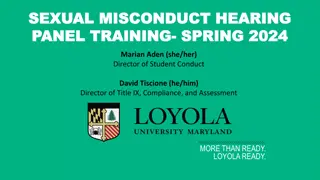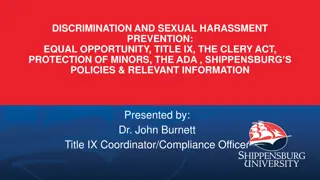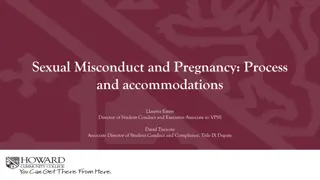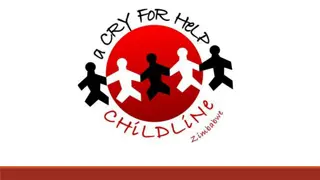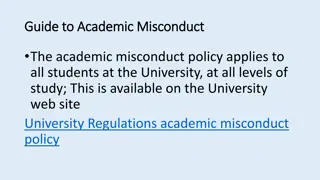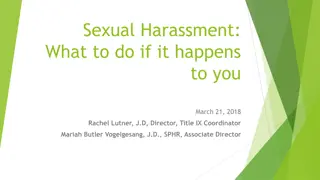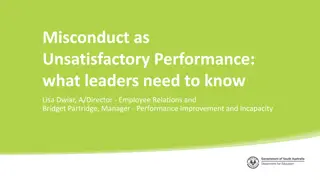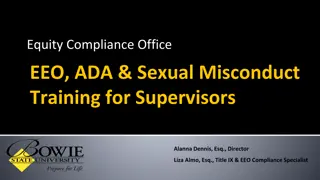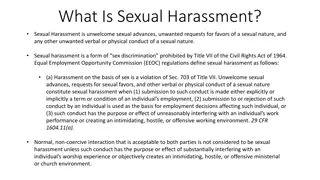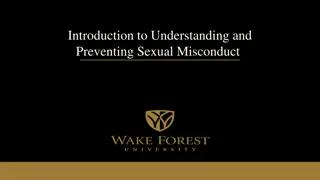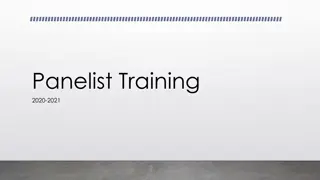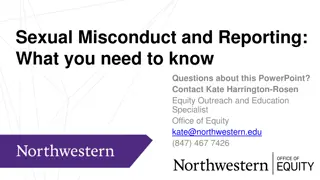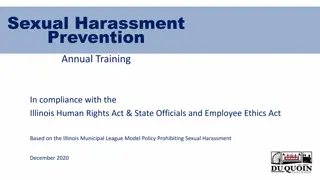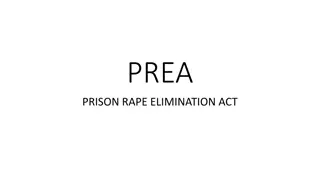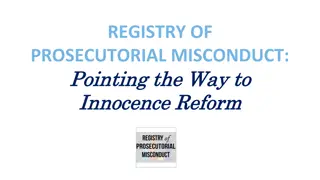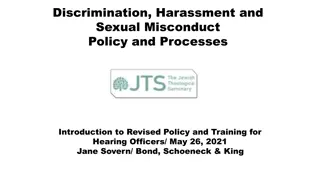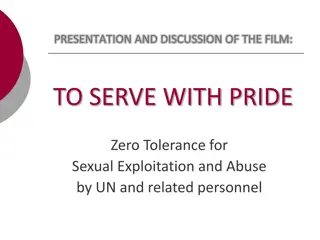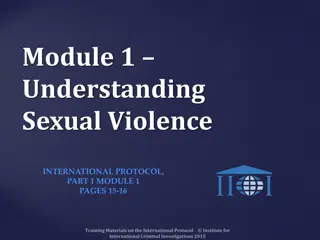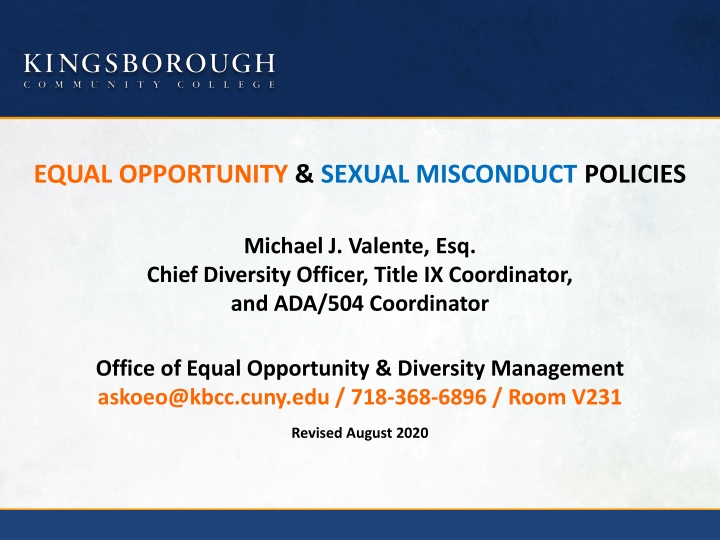
Equal Opportunity & Sexual Misconduct Policies Overview
The Office of Equal Opportunity & Diversity Management at Kingsborough Community College, under the leadership of Michael J. Valente, Esq., ensures nondiscrimination, reasonable accommodations, and a respectful workplace. Kingsborough Community College values respect, diversity, integrity, excellence, accountability, and innovation in promoting inclusion and equity in all aspects of college life. CUNY policies emphasize equal opportunity, nondiscrimination, and proactive measures against sexual misconduct to support a safe and inclusive environment for all members of the community.
Uploaded on | 0 Views
Download Presentation

Please find below an Image/Link to download the presentation.
The content on the website is provided AS IS for your information and personal use only. It may not be sold, licensed, or shared on other websites without obtaining consent from the author. If you encounter any issues during the download, it is possible that the publisher has removed the file from their server.
You are allowed to download the files provided on this website for personal or commercial use, subject to the condition that they are used lawfully. All files are the property of their respective owners.
The content on the website is provided AS IS for your information and personal use only. It may not be sold, licensed, or shared on other websites without obtaining consent from the author.
E N D
Presentation Transcript
EQUAL OPPORTUNITY & SEXUAL MISCONDUCT POLICIES Michael J. Valente, Esq. Chief Diversity Officer, Title IX Coordinator, and ADA/504 Coordinator Office of Equal Opportunity & Diversity Management askoeo@kbcc.cuny.edu / 718-368-6896 / Room V231 Revised August 2020
OVERVIEW Discrimination & Equal Opportunity Retaliation Reasonable Accommodations: Disabilities Religion Pregnancy Victim of Domestic Violence, Stalking, and Sexual Offense Sexual Harassment/Misconduct 2
Nondiscrimination and Sexual Harassment/Misconduct The LAW prohibits discrimination and sexual misconduct CUNY POLICIES prohibit discrimination & sexual misconduct Respectful, Professional workplace is good for all! Diversity is good for BUSINESS! 3
Kingsborough Community College VALUES RESPECT DIVERSITY Civility, acceptance, appreciation, and support of individual differences The proactive fostering of greater inclusion and ultimately equity at every level of college life INTEGRITY Fair and ethical standards in all policies, procedures, and practices EXCELLENCE High quality teaching, student services, administration, and community engagement; and high standards for student achievement ACCOUNTABILITYTaking responsibility for our actions and outcomes INNOVATION Creative thinking and approaches that enhance learning and support continuous improvement 4
CUNY Policies Policy on Equal Opportunity and Nondiscrimination Diversity, inclusion, and an environment free from discrimination are central to the mission of the University. It is also the University s policy to provide reasonable accommodations when appropriate to individuals with disabilities, individuals observing religious practices, employees who have pregnancy or childbirth-related medical conditions, or employees who are victims of domestic violence/stalking/sex offenses. Policy on Sexual Misconduct Every member of [CUNY s] community, including students, employees and visitors, deserves the opportunity to live, learn and work free from sexual harassment, gender-based harassment and sexual violence. 5
Policy on Equal Opportunity and Nondiscrimination EEO Protected Categories Laws Definitions Retaliation Reasonable Accommodation Confidentiality Reporting Requirements 6
Protected Civil Rights Categories Age Race Color Disability Sex (including pregnancy) Religion/Creed Gender/Gender Identity Sexual Orientation National Origin/Ethnicity Military/Veteran Status Partnership Status Marital Status Credit History Prior Record Arrest or Conviction Victims of Domestic Violence/Sex Offense or Stalking Alienage, Immigration or Citizenship Status Predisposing Genetic Information Unemployment Status Familial/Caregiver Status 7
Federal Laws The Americans With Disabilities Act of 1990 (ADA) Prohibits discrimination against people with physical or mental disabilities Equal Pay Act of 1963 Requires men & women performing substantially equal jobs receive equal pay. Uniformed Services Employment and Reemployment Rights Act of 1994 (USERRA) Prohibits discrimination based on military status Title VII of the Civil Rights Act of 1964 (Title VII) Prohibits discrimination based on race, color, religion, sex, and national origin The Age Discrimination in Employment Act of 1967 (ADEA) Prohibits discrimination against individuals age 40 and older Family and Medical Leave Act of 1993 Provides eligible employees with unpaid leave and restoration rights Pregnancy Discrimination Act of 1978 Prohibits discrimination on pregnancy, childbirth, or related conditions 8
Federal Laws contd Rehabilitation Act of 1973-Section 504 - prohibits discrimination based on disability in programs that receive funding from the U.S. Department of Education. Requires recipients to provide reasonable accommodations for employees or students with disabilities. Title VI of the Civil Rights Act of 1964 - prohibits discrimination based on race, color, or national origin in programs receiving federal funding. Title IX of Education Amendments of 1972 - prohibits discrimination based on sex in any education program receiving federal funding. Office of Federal Contract Compliance (OFCCP)- affirmative action requirements regarding women, minorities, individuals with disabilities, and protected veterans. ADA-Title II - prohibits discrimination based on disability by state and local governments. At CUNY, Italian Americans are among the protected groups for affirmative action. Invitation to self-identify in CUNYfirst (for statistical purposes). 9
What Are New Yorks Laws? NYS Labor Law Requires companies to address sexual harassment incidents with policies and annual training (online via ESPARC) New York State Human Rights Law Prohibits discrimination based on race, color, creed, age, national origin, military status, sex, sexual orientation, disability, predisposing genetic characteristics, arrest or conviction record, marital or familial status, or domestic violence victim status. NYC Workplace Religious Freedom Act Clarifies employer s obligation to provide religious accommodation. NYC Pregnant Workers Fairness Act & NYS Pregnancy Discrimination Act Employers obligations to accommodate pregnant workers. New York City Human Rights Law Prohibits discrimination based on race, color, creed, age, national origin, alienage/citizenship status, gender (gender identity and sexual harassment), sexual orientation, disability, arrest or conviction record, marital status, partnership status, or victim of domestic violence, stalking and sex offenses, credit history, and caregiver status. NYS Enough is Enough Law Addresses sexual misconduct on campuses and affirmative consent requirement. ***NYS Executive Order and NYC Law seek to increase gender pay equity,by prohibiting inquiries into an applicant s salary history. 10
Scenario Ted(Japanese ethnicity) claims that he is being targeted by his supervisor, Sam (Chinese ethnicity). Ted alleges that he is given an undesirable lunch schedule, is being denied training opportunities, and that Sam has not promoted him. Ted believes that Sam does not know how to manage and that he has poor people-skills. However, Ted admits that he does not follow Sam s instructions, is often late, and, on occasion, does not submit work on time. Ted files a complaint with the Chief Diversity Officer. Please discuss and list the pertinent issues with your colleagues. 11
Scenario Mary, a 60-year old Higher Education Assistant, has worked at CUNY for 25 years and loves her job. Her supervisor, Alex, recently hired Jane, a 30-year old Higher Ed Assistant who has 5 years of relevant job experience. Jane is energetic and highly motivated. The following year, Alex promotes Jane via reclassification. When Mary complains, Alex states that we need new blood and asks don t you want to retire? Please take a few minutes to discuss and list all the pertinent issues with your colleagues. 12
What is Employment Discrimination? Conduct or action taken against a person because of the person s protected status which adversely affects the terms and conditions of that person s employment. Consistency, Uniformity and Fairness ***Importance of documentation Legitimate Business Reason ***Totality of the Circumstances Context Matters 13
You are Protected from Discrimination in all aspects of Employment RECRUITMENT PROMOTIONS TESTING TRAINING OPPORTUNITIES HIRING TRANSFERS WORK ASSIGNMENT DISCIPLINE SALARY/BENEFITS DISCHARGE PERFORMANCE EVALUATION WORKING CONDITIONS 14
Discrimination Examples: Hiring a younger employee (age) because we want new college graduates and energized, digital natives here, even though an older worker has better education and experience. Not hiring a veteran (military) because you assume that he or she has post- traumatic stress disorder (disability). Promoting a female (gender) because you feel she is more nurturing even though a male had better evaluations in patient interaction. E.g. a nurse. Ignoring a gay employee (sexual orientation) because you believe homosexuality is wrong. You never invite the employee to work lunches or outings with co-workers. Demoting and relegating a Muslim employee (religion) to the back room because you feel that the employee s hijab (religious head scarf) is inappropriate. The Muslim employee used to work at the front desk. 15
Actual or Perceived Membership It is a violation to discriminate/harass someone because of that person s actual or perceived membership in a protected category. 16
Beware of: Stereotyping Myths Biases Assumptions based on any of the protected categories 17
Scenario: Rudy The Monster! Rudy is a manager who is very tough on his staff. Some staff members complain that Rudy is abusive, always yelling, and making demeaning and condescending comments. However, Rudy, a huge Yankee fan, has a small clique of fellow Yankee fans in the office that he treats well by approving their vacation requests, excusing their lateness, and never yelling at them. Is there a hostile work environment? How to address it? 18
What is Unlawful Harassment? Unwelcome conduct with the purpose or effect of unreasonably interfering with an individual s work performance or creates an intimidating, hostile or offensive work environment because of the individual s protected status. 19
Scenario Supervisor Joe Shmell manages his unit in a laid back way. He believes that employees should be able to joke around to relieve stress at work. He tells jokes about gay people, calls women honey, and has nick-named an Italian-American employee John Gotti. Employees in the unit often send emails to each other with insensitive racial and ethnic jokes. When spoken to by the CDO, Supervisor Shmell responded that people who are offended by these jokes are oversensitive. He also excused his joking by saying: I didn t mean to offend anyone. He added that his staff, which is racially and ethnically diverse, enjoys working for him. 20
Examples of a Hostile Environment: Calling employees racial or ethnic slurs or epithets - even one use is problematic. Sending sexual explicit emails to coworkers or subordinates. Drawing a swastika on a bathroom wall. Making jokes about race, sexual orientation, sex, religion, gender identity, etc. Unwelcome touching and sexual advances. A supervisor or manager who allows such a hostile environment may be personally liable and subject to appropriate disciplinary action. 21
Retaliation It is unlawful and a violation of the EO Policy to retaliate against someone who has: Filed an EO complaint Participated in an EO investigation Opposed discrimination or discriminatory harassment Requested a reasonable accommodation Things to Remember: Maintain confidentiality. DO NOT RETALIATE! Treat the Same as Similarly- Situated persons. 22
Examples of Retaliation: Firing an employee after you find out that he filed a complaint against you. Suddenly scrutinizing and nit-picking an employee who participated as a witness in an EO investigation. Giving a bad evaluation because an employee simply complained about the harassment a co-worker was being subjected to. Professional isolation ignoring or keeping someone out of the loop. 23
Reasonable Accommodation An individualized action taken to adapt or adjust for a person s: 1. Disability 2. Religious need or practice 3. Status as a victim of domestic violence, sex offense or stalking, or 4. Pregnancy, child-birth or related medical conditions: done in a way that does not impose an undue hardship. *Cooperative Dialogue/Interactive, Communicative process: CUNY Procedures for Reasonable Accommodations and Academic Adjustments 24
Reasonable Accommodation contd If you need an accommodation or become aware of a request for an accommodation, you should immediately: Get Human Resources involved. HR will work with parties to discuss accommodations, essential job functions, employee limitations, and undue hardship Matter is to be kept CONFIDENTIAL Invite Individuals with Disabilities to Self-Identify in CUNYfirst. DO NOT engage in retaliatory conduct DO NOT take adverse action or make negative comments about the employee s approved accommodations/leaves. E.g. He s always out sick. 25
Examples of reasonable accommodations: Modifying work schedules Granting breaks or providing leave Moving to different office space Reconfiguring work spaces/equipment Providing assistive technology/equipment 26
What is NOT a reasonable accommodation? Removal of an essential job function Hiring someone to do your job Undue hardship on employer: financial, administrative Lowering performance or conduct standards Instead, UNIFORM, CONSISTENT APPLICATION of STANDARDS! 27
EO Policy Complaint Procedures ContactChief Diversity Officer Michael J. Valente, Esq. call 718-368-6896, visit Room V231 or email Confidential Process - Information may be disclosed on a need-to-know basis Informal Resolution (30 days) or Investigation (60 days) takes place: Parties and Witnesses interviewed Documents reviewed Reasonable Determination based on evidence presented Review of findings by the President Appropriate remedial action is taken, if warranted 28
Remedies Immediate Preventive Action to protect University community; separate parties Training Counseling Discipline Up To and Including Termination of Employment 29
Managers and Supervisors Mandated Reporters must contact CDO Maintain Confidentiality Cooperate with the Investigation Agents Can be held personally liable Model Behavior expected of Employees NO RETALIATION! Hold employee to same standards as similarly-situated persons Clearly Communicate work expectations Progressive Discipline 30
Employees Reporting Requirements May go directly to the CDO to file internal EEO complaint (need not complain first to supervisor) Maintain Confidentiality Cooperate Fully with the investigation Can file complaints externally with EEOC Office for Civil Rights (OCR) State Division of Human Rights (SDHR), and City Commission on Human Rights (CCHR), or file a lawsuit 31
Policy on Sexual Misconduct Sexual Harassment Other Harassment based on Sex Sexual Violence: Sexual Assault Domestic/Intimate Partner/Dating Violence Stalking Voyeurism 32
Scenario Don Juan likes to joke around in the office. As such, he is generally well-liked. However, Don Juan likes to talk about his sex life and makes jokes about sexual topics. Also, he has given various nick names to his co- workers. For example, he calls Joe sweet cheeks, Mary honey pie, and Sue Big Ho. Does CUNY Policy prohibit Don Juan s conduct? How would you address this matter, if you were Sue? If you were Don Juan s supervisor? 33
What Is Sexual Harassment? Sexual harassment is any unwelcome conduct of a sexual nature, including sexual advances, and requests for sexual favors, that creates an intimidating, hostile, or offensive environment because of gender. The effect of the conduct will be evaluated based on the perspective of a reasonable person in the position of a Complainant. Sexual harassment is considered a form of employee misconduct and an employee who engages in such conduct, or managerial and supervisory personnel who knowingly allow such behavior to continue, shall be subject to discipline in accordance with applicable rules, policies and collective bargaining agreements. 34
Examples of Sexual Harassment: Sexual comments, teasing, or jokes Inappropriate or unwelcome physical contact, such as touching, groping, patting, pinching, hugging, kissing, or brushing up against an individual s body Sexual slurs, demeaning words, or other verbal abuse Graphic or sexually suggestive comments Inquiries or discussions about sexual activities Pressure to accept social and/or electronic invitations, to meet privately, to date, or to have sexual relations Sexually suggestive letters or other written or visual communication, including email, text, Snapchat, photo and other social media communications 35
Other Harassment based on Sex Unwelcome conduct of a nonsexual nature based on an individual s actual or perceived sex or sexual orientation, including conduct based on gender identity, gender expression or non-conformity with gender stereotypes Examples: Intentionally using the wrong pronoun to identify a transgender individual Mocking a person s appearance Malicious gossip about a transgender individual Refusing to Allow Individuals to Use Single-Sex Facilities Consistent With Their Gender Identity 36
What is Sexual Violence? Consists of: Sexual assault, such as rape/attempted rape, forcible touching, fondling, groping, grabbing and rubbing Dating, intimate partner, domestic violence Stalking /Cyberstalking Voyeurism (unlawful surveillance, violation of right to privacy in connection with person s body and/or sexual activity) 37
Sexual Assault Sexual assault is a crime. Sexual assault is any form of sexual contact that occurs without consent and/or through the use of force, threat of force, intimidation, or coercion. Rape, attempted rape, forcible touching, criminal sexual act, and sexual abuse. Sexual assault can be committed when someone has not given or is unable to give consent, for example, because of intoxication. Sexual assault can be a form of sexual harassment. 38
Dating / Intimate Partner / Domestic Violence Dating/Intimate Partner/Domestic violence includes: a pattern of coercive conduct that can include physical, psychological, sexual, economic and emotional abuse perpetrated by one person against an intimate partner. a single incident of sexual assault. does not need to be sexual in nature. CUNY Policy On Domestic Violence and Workplace (nondiscrimination, reasonable accommodations for victims) 39
Stalking Stalking is a crime Stalking is a course of conduct directed at a specific person with whom the perpetrator currently has, previously had, or desires to have some form of sexual or romantic relationship -- that causes that person reasonable fear or distress Stalking includes repeated behaviors that harass or threaten the victim, such as following a person, appearing at a person s home or place of business, or sending harassing calls, messages or photos Stalking includes cyberstalking using electronic forms of communication, including social media Stalking does not have to be sexual in nature 40
Incident Reporting If you experience or observe sexual misconduct/violence, you can contact the Title IX Coordinator, Human Resources Office, or Public Safety Office or Call 911 immediately! Also, PRESERVE evidence!! .41
ANYONE Can be a Victim of Sexual Misconduct Victims include those of any: gender gender identity sexual orientation physical or mental ability religious affiliation citizenship status Race / class, or Educational level Sexual misconduct can also occur between members of the same sex/gender. 42
What Is Affirmative Consent? Consent is a knowing, voluntary and mutual decision among all participants to engage in agreed upon sexual activity. Consent can be given by words or actions, as long as they create clear permission to engage in the sexual activity. Each person must clearly communicate his/her willingness and permission to engage in sexual activity. A person who is drunk or high may not be able to consent. Having sex with a person who is passed out, or slides in and out of consciousness, is rape. Failure to resist or say no does not equal consent. Silence does not constitute consent. 43
Regarding Consent: Past consent to sexual relations does not constitute consent to subsequent relations Consent to one form of sexual activity does not imply consent to other forms A person s appearance/dress does not communicate consent During an encounter, a person may consent to certain sexual acts and not to others. A person under 17 years old cannot consent to sexual intercourse under New York law CUNY Policy prohibits faculty members and other employees from engaging in consensual intimate relationships with students for whom they have a professional responsibility CUNY Policy strongly discourages consensual intimate relationships between a supervisor and supervisee. Such relationships must be disclosed to the supervisor s supervisor 44
Reporting a Sexual Misconduct Complaint All individuals who believe they have experienced or witnessed sexual misconduct are strongly encouraged to report the incident to campus authorities. Please view CUNY s Title IX Webpage Enough is Enough: Combating Sexual Misconduct at http://www1.cuny.edu/sites/title-ix/campus/university/. Employees can report to: Title IX Coordinator Director of HR Office of Public Safety 45
Sexual Misconduct Complaints: Complaints are promptly investigated by the Title IX Coordinator, or his/her designee, with assistance from Public Safety and Human Resources. All students and employees are encouraged, though not required, to report all incidents of sexual violence to the NYPD. Public Safety can help with filing a police complaint. It is the Complainant s choice. Parties can receive assistance, interim/supportive measures, and resources from the institution. 46
Filing an External Complaint The following federal, state, and local agencies enforce laws against sexual misconduct or sex discrimination. If you are a victim of sexual misconduct or sex discrimination, you may file an external complaint with these agencies, or you may file litigation in a court of competent jurisdiction. Depending on the forum, the time to file and the available remedies may vary based on the applicable statutes of limitations. New York City Commission on Human Rights http://www1.nyc.gov/site/cchr/index.page New York State Division on Human Rights http://www.dhr.ny.gov US Equal Employment Opportunity Commission http://www.eeoc.gov US Department of Justice http://www.justice.gov/ US Department of Education, Office for Civil Rights http://www2.ed.gov/ocr 47
Responsible Employees REQUIRED to report incidents of sexual misconduct to the Title IX Coordinator Title IX Coordinator and staff Office of Public Safety employees Vice President for Student Affairs and Dean of Students and all staff in those offices (except Confidential employees) Residence Life staff in CUNY owned or operated housing, including Resident Assistants College President, Vice Presidents and Deans Athletics Staff, Faculty Athletics Representatives Department Chairpersons/Executive officers International Education Liaisons/Study Abroad Directors 48
Responsible Employees, contd REQUIRED to report incidents of sexual misconduct to the Title IX Coordinator Human Resources Director and Deputy Director College/Unit attorney and staff College/Unit labor designee Faculty/staff members when leading off-campus trips Employees who are managers or supervisors College Childcare Center staff 49
Managers and Supervisors As Responsible Employees, managers and supervisors are mandated to report complaints or incidents of sexual misconduct, including sexual harassment, to the Title IX Coordinator As Agents of institution Can be held personally liable Sanctions will be enforced against Managers and Supervisors who knowingly allow sexual misconduct or sexual harassment to continue Model Behavior expected of Employees NO RETALIATION! 50

